Safflower
Safflower, Carthamus tinctorius, is a highly branched, herbaceous, thistle-like annual plant. It is commercially cultivated for vegetable oil extracted from the seeds and was used by the early Spanish colonies along the Rio Grande as a substitute for saffron.[2] Plants are 30 to 150 cm (12 to 59 in) tall with globular flower heads having yellow, orange, or red flowers. Each branch will usually have from one to five flower heads containing 15 to 20 seeds per head. Safflower is native to arid environments having seasonal rain. It grows a deep taproot which enables it to thrive in such environments.
| Safflower | |
|---|---|
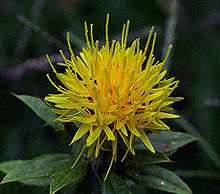 | |
| Scientific classification | |
| Kingdom: | Plantae |
| Clade: | Tracheophytes |
| Clade: | Angiosperms |
| Clade: | Eudicots |
| Clade: | Asterids |
| Order: | Asterales |
| Family: | Asteraceae |
| Genus: | Carthamus |
| Species: | C. tinctorium |
| Binomial name | |
| Carthamus tinctorium | |
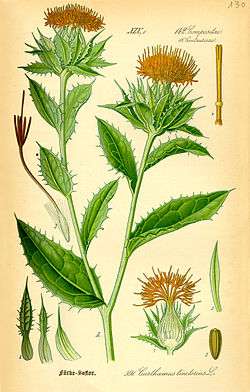
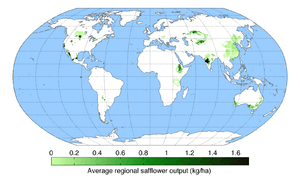
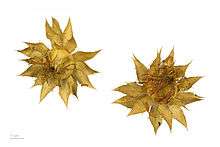
History
Safflower is one of humanity's oldest crops. It was first cultivated in Mesopotamia, with archaeological traces possibly dating as early as 2500 BC.[3]
Chemical analysis of ancient Egyptian textiles dated to the Twelfth Dynasty (1991–1802 BC) identified dyes made from safflower, and garlands made from safflowers were found in the tomb of the pharaoh Tutankhamun.[4] John Chadwick reports that the Greek name for safflower (kārthamos, κάρθαμος) occurs many times in Linear B tablets, distinguished into two kinds: a white safflower (ka-na-ko re-u-ka, knākos leukā, κνάκος λευκά), which is measured, and red (ka-na-ko e-ru-ta-ra, knākos eruthrā, κνάκος ερυθρά) which is weighed. "The explanation is that there are two parts of the plant which can be used; the pale seeds and the red florets."[5]
The early Spanish colonies along the Rio Grande in New Mexico used safflower as a substitute for saffron in traditional recipes. An heirloom variety originating in Corrales, New Mexico, called "Corrales Azafran", is still cultivated and used as a saffron substitute in New Mexican cuisine.[2]
Production
In 2018, global production of safflower seeds was 627,653 tonnes, led by Kazakhstan with 34% of the world total.[6] Other significant producers were the United States and India, with 26% of world production combined.[6]
Uses
Traditionally, the crop was grown for its seeds, and used for coloring and flavoring foods, in medicines, and making red (carthamin) and yellow dyes, especially before cheaper aniline dyes became available.[4]
Edible oil
For the last fifty years or so, the plant has been cultivated mainly for the vegetable oil extracted from its seeds. Safflower seed oil is flavorless and colorless, and nutritionally similar to sunflower oil. It is used mainly in cosmetics and as a cooking oil, in salad dressing, and for the production of margarine. INCI nomenclature is Carthamus tinctorius.
There are two types of safflower that produce different kinds of oil: one high in monounsaturated fatty acid (oleic acid) and the other high in polyunsaturated fatty acid (linoleic acid). Currently the predominant edible oil market is for the former, which is lower in saturated fats than olive oil. The latter is used in painting in the place of linseed oil, particularly with white paints, as it does not have the yellow tint which linseed oil possesses.
In one review of small clinical trials, safflower oil consumption reduced blood low-density lipoprotein levels – a risk factor for cardiovascular diseases – more than those seen from butter or lard consumption.[7]
Flowers for human consumption
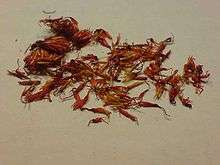
Safflower flowers are occasionally used in cooking as a cheaper substitute for saffron, sometimes referred to as "bastard saffron".[8]
The dried safflower petals are also used as a herbal tea variety.
Dye from flowers
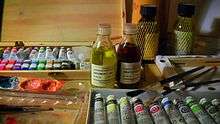
In coloring textiles, dried safflower flowers are used as a natural dye source for the orange-red pigment carthamin.[4][9] Carthamin is also known, in the dye industry, as Carthamus Red or Natural Red 26.[10]
In Japan, dyers have mastered the technique of producing a bright red to orange-red dye (known as carthamin) from the dried florets of safflower (Carthamus tinctorius). Darker shades are achieved by repeating the dyeing process several times, having the fabric dry, and redyed.
Biodegradable oil
In Australia in 2005, CSIRO and Grains Research and Development Corporation launched the Crop Biofactories initiative to produce 93% oleic oil for use as a biodegradable oil for lubricants, hydraulic fluids, and transformer oils, and as a feedstock for biopolymers and surfactants.[11]
References
- "Tropicos". Missouri Botanical Garden, St. Louis, MO. 2016. Retrieved 16 June 2016.
- "Corrales Azafrán - Native-Seeds-Search". shop.nativeseeds.org.
- Pearman, Georgina (2005). Prance, Ghillean; Nesbitt, Mark (eds.). The Cultural History of Plants. Routledge. p. 150. ISBN 0415927463.
- Daniel Zohary, Maria Hopf, Ehud Weiss (2012). Domestication of Plants in the Old World: The Origin and Spread of Domesticated Plants in Southwest Asia, Europe, and the Mediterranean Basin, 4th edition, page 168. Oxford University Press. ISBN 978-0199549061.CS1 maint: uses authors parameter (link)
- John Chadwick, The Mycenaean World (Cambridge: University Press, 1976), p. 120
- "World production of safflower seeds in 2018; World Regions/Crops/Production from pick lists". United Nations Food and Agriculture Organization, Statistics Division (FAOSTAT). 2019. Retrieved 5 May 2020.
- Schwingshackl, Lukas; Bogensberger, Berit; Benčič, Aleksander; Knüppel, Sven; Boeing, Heiner; Hoffmann, Georg (2018-09-01). "Effects of oils and solid fats on blood lipids: a systematic review and network meta-analysis". Journal of Lipid Research. 59 (9): 1771–1782. doi:10.1194/jlr.P085522. ISSN 0022-2275. PMC 6121943. PMID 30006369.
- E.g. "safflower" in Webster's Dictionary, year 1828. E.g. "bastard saffron" in The Herball, or General Historie of Plantes, by John Gerarde, year 1597, pages 1006-1007.
- Dweck, Anthony C. (ed.) (June 2009), Nature provides huge range of colour possibilities (PDF), Personal Care Magazine, pp. 61–73, retrieved 30 Oct 2012CS1 maint: extra text: authors list (link)
- "Carthamus red; In: Compendium of Food Additive Specifications. Addendum 5. (FAO Food and Nutrition Paper - 52 Add. 5)". FAO/WHO Expert Committee on Food Additives. 1997. Retrieved September 20, 2016.
- Lee, Tim (7 June 2020). "Safflower oil hailed by scientists as possible recyclable, biodegradable replacement for petroleum". ABC News. Landline. Australian Broadcasting Corporation. Retrieved 7 June 2020.
External links
| Wikimedia Commons has media related to Carthamus tinctorius. |
- Safflower field crops manual, University of Wisconsin, 1992
- The Paulden F. Knowles personal history of safflower germplasm exploration and use, University of California-Davis, Department of Plant Sciences
| Look up safflower in Wiktionary, the free dictionary. |